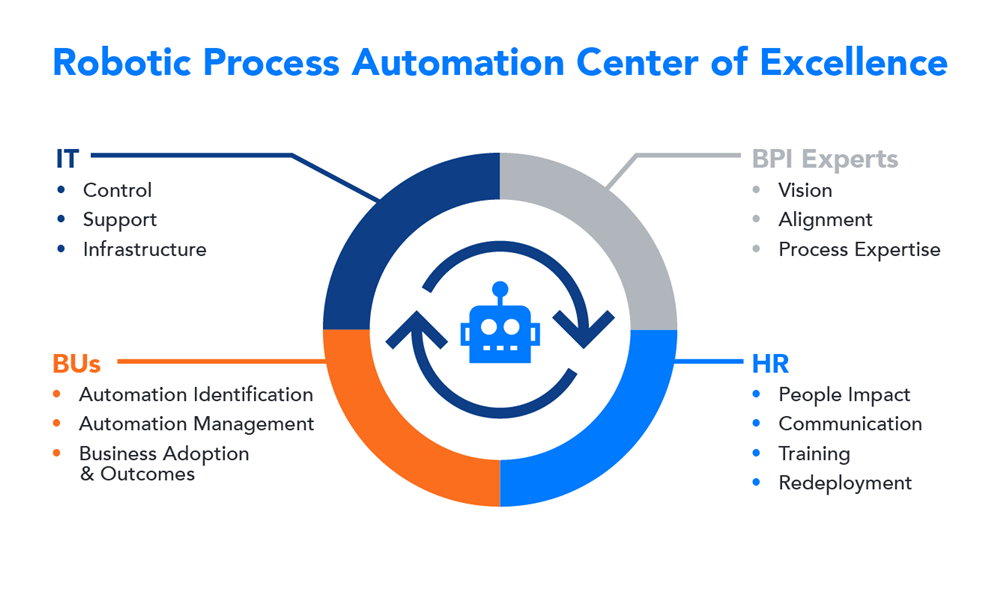

Are you like many organizations and just finished your first (or fifth) pilot of Robotic Process Automation (RPA)?
Good for you. But you are probably asking yourself, now what? How do I scale this across my org?
You’re not alone. RPA adoption has been slow and siloed. In fact:
According to Deloitte:
“Only three percent of organizations had managed to scale RPA to a level of 50 or more robots.”
– The Robots Are Ready. Are You? Deloitte, 2017
Here’s the deal:
RPA has the potential to transform how we work. Gone are the boring, repetitive tasks. Employees can now focus on the more challenging, rewarding work. Work that requires creativity, problem solving and collaboration.
However, according to Gartner, many organizations:
“Jump into RPA initiatives without proper analysis, planning, defined strategies & Centers of Excellence.”
– Predicts 2019: RPA Evolution, Gartner
Not very reassuring, huh? But there is hope.
With a little organization and forethought, organizations can start small, leverage existing talent, and build the skills and framework they need to effectively scale RPA.
An RPA Center of Excellence provides the governance, communication and support needed to deploy and manage RPA automations across your organization.
The report gives a detailed description of the key components of an RPA Center of Excellence (CoE). For today, let’s just focus on the framework and core responsibilities.
What Is an RPA Center of Excellence Framework?
An RPA CoE will typically sit within the Shared Services group as their charter is to:
- Find synergies across business units
- Streamline and improve overall operations
- Drive continuous improvement.
The CoE includes, but is not limited to, process experts, business analysts, IT and HR, and business unit leaders.

Now if you are like me, you look at this diagram and immediately see the clash of the Titans — IT vs. the business units. An RPA CoE straddles these two groups, who can hopefully play nice together. Each group has their specific roles, but the lion’s share of the design, implementation and ownership of the automations lives within the business units.
That’s right, the business units — not IT.
It just makes sense. Managers and process owners within the business units are:
- Closest to the work
- Understand the process flows
- Know where there are pain points that could be solved by RPA.
In fact, you might be surprised to learn that many organizations take a grass roots approach to automation — asking employees to make suggestions on what to automate to make their lives easier.
Here’s a true-life example. An account manager for a data processing vendor had one part of her job that was VERY tedious. She had to set up, download, organize and submit important validation reports and files that were critical to the success of each project This highly manual process took HOURS to complete and was prone to errors. In addition, validation report creation occurred during peak, go-live activity, when every minute counted.
The account manager volunteered for an RPA pilot and immediately suggested automating this process. Now all she needs to do is to complete a simple Excel template and email the file to the RPA robot — and the robot takes care of the rest.
For her, the skies opened and heavenly choirs began to sing! It was life changing. She immediately identified three more tedious, rules-based processes for automation. Now she and the other account managers can get customers up and live faster with fewer errors.
RPA Center of Excellence Core Responsibilities
A Robotic Process Automation CoE is designed to break down organizational barriers and help you maximize the benefits and return on investment (ROI) you gain from these automation tools. Core responsibilities include:
- Governance
- Communication and collaboration
- Enablement and support
Stay with me here as I walk you through each of these.
What Is RPA Governance?
An RPA CoE will create a governance framework that will drive consistency across functions in your automation strategy, approach and implementation.
Good news! This is where you can leverage your existing business process improvement (BPI) experts. These BPI gurus can help you identify and prioritize tasks and processes for automation. They would be responsible for developing a scoring methodology to rank automations. Ranking factors can include:
- Volume – # of times the task/process is performed
- Number of people who perform this task
- Complexity of the task, on a scale of, say, 1 to 5
- The stability of the applications involved (how often are the applications upgraded or modified)
- The number of possible variations to the process
- The number of decision points (need for human interaction) involved
- The cost or anticipated value of the automation (time savings, quality improvement, customer satisfaction, etc.)
I know it sounds complicated, but it’s really not that hard. Your organization likely already has a lot of this data. You just need to figure out what’s most important to you, and weight the factors that will influence the outcomes you are trying to achieve.
How do you get started? Try these three tools to help you identify and prioritize process automations.
Still with me? Great. Let’s discuss the next responsibility of an RPA CoE.
Communication and Collaboration
One of the greatest challenges when deploying RPA is overcoming people concerns. Employees fear they will be replaced. Managers wonder how having RPA robot employees will impact the way they manage their teams. Executives worry they won’t see the promised ROI.
The RPA CoE will need to coordinate with Human Resources (HR), IT, and the business units to communicate:
- The company’s objectives for automation
- The value this will bring to their individual roles
- How the robots will be managed
- Who they can turn to with questions and concerns.
Earlier, I mentioned the Clash of the Titans. This is more like herding cats — getting the business units, IT, HR, line managers and the employees all onto the same page and moving toward the same goal. We’ve all been there before. We’ve corralled the business and been able to work collaboratively to achieve a goal. We did it before and we can do it again.
In this case, the business units will need to take the lead in coordinating and building an actionable change management plan that helps ensure RPA software adoption and achievement of desired business outcomes.
Building a culture of collaboration between the field and the RPA CoE will help maximize the scalability and adoption of automation across your organization.
Almost there! We’ve discussed governance and communication. Now for the final RPA CoE responsibility.
According to Ovum, for organizations to scale up RPA:
“Cross functional teams and their ability to collaborate will be key.”
– 2019 Trends to Watch: Automation, Ovum
RPA Enablement and Support
Most RPA software solutions are “business-user friendly,” meaning automations can be created without the need for coding or IT skills. However, to scale RPA automations across an enterprise, a core group of RPA technical experts will be needed. This core group would be responsible for:
- Ensuring the technical environment is operational (e.g., virtual servers for unattended RPA robots or assistant robots on the desktop)
- Working with IT to understand upcoming infrastructure, system or application changes that could impact RPA automations.
- Testing RPA automations to ensure they meet security and governance standards
- Training business units and end users on the RPA solution
- Monitoring and managing the robots
- Acting as an internal “help desk” for RPA-related issues/questions
- Managing change requests for automations.
The benefits of RPA automation can be tremendous — not only in time savings, but in greater quality, consistency, compliance, and customer and employee engagement.
For example, a large financial services firm wanted to be the automobile lender of choice. To do so it needed to be faster at responding to dealer requests. However, their adjudication process was slowing them down. The company employed 10 full-time employees to manually sort loan applications into the right adjudicator’s work queue based on customer history, credit rating, loan value, and other parameters.
Leveraging RPA, they were able to automate this process without a lengthy data integration or fancy software coding. The results speak for themselves.
The financer reduced the time it took to collect, assess, and assign loans to adjudicators by 50 percent; from 6 minutes to 3 minutes. They were able to redeploy half of the FTEs assigned to this process, saving an estimated $250,000 per year. They also increased quality, removed human error, and reduced risk by preventing lenders from approving applications outside of their authority limits.
Ultimately, they improved the experience of their customers — and made themselves the lender of choice for their region.
So let’s recap.
An RPA Center of Excellence can help you scale automation across your organization in a consistent manner that will help drive ROI and desired outcomes. What do you think? Do organizations need an RPA CoE? Can you suggest other ways organizations can effectively scale RPA automation across the enterprise? Please add your comments and thoughts below.